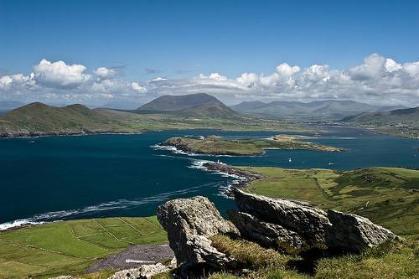Archaeologist issues report which backs up local folklore
Patrick Counihan
Source - http://www.irishcentral.com/news/Kerry-island-structure-may-be-due-to-tsunami-waves-in-medieval-times-163836556.html

Beginish and Church Islands from Valentia Isalnd - Photo by Reencaheragh Cottage
Claims that tsunami type waves may have hit the Kerry coastline in medieval times have been backed up a leading archaeologist.
Alan E Hayden, the director of more than 200 medieval excavations in Ireland, believes the grouping of islands off the Kerry coast suggests earthquake and tsunami wave style damage.
The Irish Times reports on Hayden’s views on the theory that the south Kerry coast has, over the centuries, been struck by long tsunami waves of over 50 feet.
Hayden cross-checked folk tales with archaeological and geological evidence and said the grouping of Valentia, Beginish and Church islands may ‘bear the scars of earthquakes and tsunami-type waves in medieval times’.
The latest edition of the Journal of the Kerry Archaeological and Historical Society has recorded his findings.
The Irish Times reports that he concluded that damage to the south and southwest surrounding walls of Church Island, an important early medieval ecclesiastical site, was ‘unlikely to have been caused by a storm or heavy swell’.
He argues that the disappearance of the dry-stone wall at the south of Church Island could be due to the much longer wavelength of a tsunami, probably coming from an earthquake in the southwest.
Hayden also suggests that there are indications that Church Island may have been connected to Beginish Island but that the wave led to erosion of the connecting land. A sand bar still partly connects the two islands.
Church Island became home to a monastic settlement in the seventh century. Before that it was a centre for fuel for iron smelting.
The Times report adds: “A folk tale collected by a teacher in the early part of the last century offers an explanation for local place names connected to a road that ran from Dolus Head through the islands to Skellig.
“The road, a pre-medieval structure, is called Bóthar na Scairte, or road of the cataclysm, and it is traceable for some distance on Valentia. In the folk tale the road and a local hero were destroyed by a great cataclysm, probably an earthquake followed by a wave.
“According to the tale, ‘a terrible wave 50ft high’ rushed towards a gathering of people on a summer day on Valentia. Everyone except the hero scrambled to higher ground. The wave separated Skellig and Valentia from each other.”
Hayden says that the occurrence of tsunamis affecting the south and west coasts of Ireland is surprisingly well documented.
A 1775 earthquake in the Portuguese capital Lisbon caused a tsunami which reached Kinsale and which flooded the Spanish Arch in Galway.
He also noted that in the 1850s a tidal wave washed 15 men off the cliffs of Inishmore.
Hayden wrote: “The British Geological Survey has suggested that earthquakes on a known unstable fault that lies off the southwest coast of Ireland may have caused some of these tsunamis.”